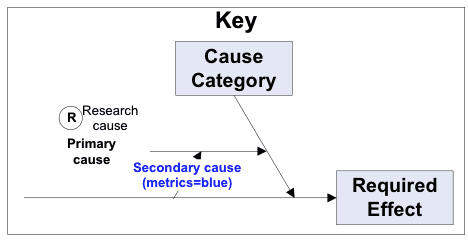Using Cause-and-effect or Ishikawa fishbone diagrams for marketing analysis and management
If you’re involved with managing Ecommerce, there are many inter-related marketing activities that are important for success. With the increasingly complex range of channels companies use for communications today and alternative customer journeys on site, mastering best practices is helpful to make best use of each channel or digital marketing technique and how it integrates with other channels.
I first started to use Ishikawa diagrams when I was responsbible for managing software development teams where we used them to identify the potential cause of problems and minimise bugs. As I got involved in digital marketing I was reminded them when I heard Sam Decker, then responsible for Dell’s consumer web site, explaining how Dell used this as part of their Six Sigma thinking to improve operations, content, design, analytics, and P&L management. This technique seemed to me to be a perfect fit for many aspects of modern marketing, but particularly creating digital experiences and customer service since processes for systems development, integration and workflow are now so important in digital marketing. So I've created a top-level Ishikawa template for Smart Insights Expert members to summarise the success factors for transactional Ecommerce sites. It's structured around our RACE planning framework so can be applied to other sectors too.
Using the right levers to impact sales
But how do you check you have considered all the relevant factors that will keep your Ecommerce optimisation on track? At Smart Insights we hope to help by developing frameworks that help managers or consultants think-through or analyse complex challenges of managing digital marketing. Our RACE marketing strategy framework is one way we have looked to simplify all the different activities that need to be managed. In this post I’ll describe another approach which helps you define the main success factors for online marketing.
The way I see it, successful digital marketing involves management of different levers that affect performance, some more important than others. Think of the old-school railway signal boxes - there is a straightforward cause and effect with different levers having a different impact, but each important.

Managing digital marketing today is more akin to this nuclear power station control console.

Or at least a social media command centre like this...

Identifying the right levers for Ecommerce
So, for success in managing Ecommerce you need to consider the most effective levers to pull. How should we define these? There is a natural tendency for us to focus on the “low hanging fruit” or efficiency factors whereas (see my post defining Efficiency vs Effectiveness) whereas it’s often the more challenging Effectiveness factors that will have the biggest impact. For example, I’ve head Karl Blanks of Conversion Rate Experts, talks about how conversion rate optimisation for Ecommerce sites can suffer from “meek tweaking” where optimisation is limited to template features or copy as part of CRO, rather than pulling the more significant levers of value proposition or customer journeys on the site.
Similarly, I’ve also heard Angus Cormie, EMEA Online Marketing Director at Dell describe how Dell divide their key performance drivers into Tactical on-page levers of messaging and usability and Strategic online levers such as merchandising (e.g. reviews and ratings, product videos); major site path changes; decision-support tools (e.g. help-me-choose and comparison tables) and different merchandising toolkits such as product customisation and offer personalisation, real estate optimisation and message balancing.
Applying cause-and-effect diagrams for marketing analysis
A technique that I have used for a while to help in my analysis of digital marketing for businesses are cause-and-effect diagrams. You may have heard of them as Ishikawa or Fishbone diagrams too.
If you look at the example that’s used in the Wikipedia entry for Ishikawa diagrams you can see why they’re called Fishbone diagrams. Kaoru Ishikawa was a Japanese University professor and proponent of quality management practices in industry culminating in the publishing of the Ishikawa diagram in his books of the 1980s.

I first heard about the technique around ten years ago when there was a movement to adopt Six Sigma principles in marketing. Dell was one of the earliest adopters of the technique in marketing and I was influenced by Sam Decker, then an Ecommerce manager at Dell in the US as he described their benefits and how Dell had used them. Since then I have used them on various consulting projects and for reviewing the structure of search marketing best practice guides for example. I also talk about them on training courses and there seems to be interest in the technique, so I thought I’d write up how I use the technique.
Note though, that the way I use them isn’t the classical method since Ishikawa diagrams originate in the process manufacturing industry where they are most commonly used to identify defects in operations and techniques to reduce the problem. So I call the technique “success mapping” since it’s more about defining the different marketing activities used to improve performance rather than solving a particular problem. Of course, you can consider the reverse, which are the problems that are limiting sales…
Identifying the right strategic levers
For me, success maps offer a way of driving growth and improved performance of a channel since they give a structured way to understand, prioritise and manage best practices for marketing activities. They offer these benefits:
- They’re directed at identifying factors to drive growth, measured using their impact on KPIs
- Help manage processes with complex best practices of marketing activities
- Grouped related activities and show dependencies between different activities
- Use to identify and prioritise improvement activities when managers are discussing with specialists or agencies. They give a visual hierarchy for activities on a single sheet
They are also handy to review knowledge as part of learning, for example revision or planning an exam question. They can be used in a simple way as a specialist form of mindmap.
How to create and use Marketing Success Maps
In our updated Ecommerce success map template for Expert members, we give an example high-level success map that covers a typical range of best practices, but the approach is relatively simple and you may want to develop your own for other processes you are working on. To create a success map:
- Start on the right of the diagram, defining your overall aim(s) for the activity you want to improve.
- Use specific goals and KPIs to define how you will measure the process or activity you are looking to improve.
- Identify the 3–8 main groups of work activities or tasks that will drive performance. It can help to use a conventional mindmap which is similar in many ways, but not so process driven.
- Draw 3–8 arrows of main activities driving performance angled towards the right onto the main axis which will drive activity. Where there is a clear sequence of activities, e.g. start on the left if auditing is part of the activity on the left.
- Add individual primary tasks and secondary sub-tasks or activities onto each major grouping of activities. It's useful to show how you will research the cause and find a way of showing the metrics or KPIs too.

If you haven’t encountered the Ishikawa technique before I hope you find it interesting and are inspired to try using it. Let me know how you get on. It’s a bit of a marmite (love it or hate it) technique since the output can be cramped and not aesthetically pleasing - not always something you will want to show to colleagues and clients, but useful for your own analysis. If you have used the technique before please share how you have applied the technique with any recommendations. Thanks!











